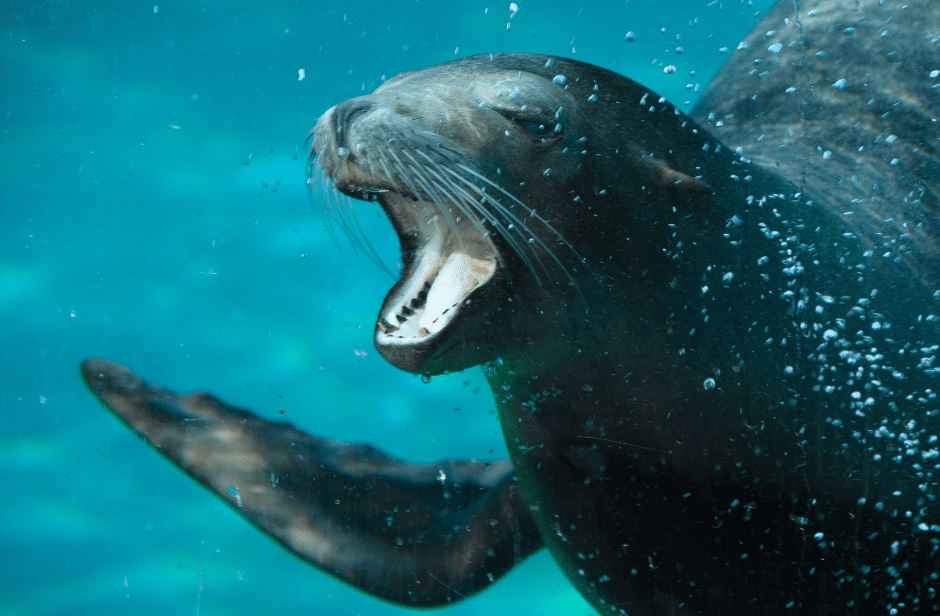Sea lions are generally not aggressive towards humans, but they can become territorial if they feel threatened or if they are protecting their young. It is best to keep a safe distance from sea lions and avoid approaching them too closely. If you encounter a sea lion on land, do not touch or feed it, as this can cause the animal to become aggressive. If a sea lion approaches you in the water, try to slowly and calmly swim away.
Sea lions are a type of marine mammal that are known for their intelligence and playful nature. They can be found along the coastlines of North and South America, and are often seen basking on rocky outcroppings or swimming in the ocean.
While sea lions are generally not aggressive towards humans, it’s important to understand their behavior and how to safely interact with them.

Habitat and Distribution
Sea lions can be found along the coastlines of North and South America, including the Galapagos Islands, California, and the northern coast of South America.
They can be found in a variety of habitats, including rocky shores, sandy beaches, and offshore islands. Sea lions are known to be highly adaptable, and can survive in both warm and cold water environments.
Behavior and Characteristics
Sea lions are known for their intelligence and playful nature. They are social animals and can often be seen basking in large groups on rocky outcroppings or swimming in the ocean. They are skilled swimmers and divers, and can hold their breath for several minutes at a time. Sea lions are also known to be vocal creatures, and their vocalizations can range from barks and growls to more complex calls.
Male sea lions, called bulls, are larger than females and can weigh up to 800 lbs. They are also known to be more aggressive than females, especially during the breeding season.
Female sea lions, called cows, can weigh up to 300 lbs. They are generally more docile and are responsible for caring for their young.

Interaction with Humans
While sea lions are generally not aggressive towards humans, they can become territorial if they feel threatened or if they are protecting their young. It is best to keep a safe distance from sea lions and avoid approaching them too closely.
If you encounter a sea lion on land, do not touch or feed it, as this can cause the animal to become aggressive. If a sea lion approaches you in the water, try to slowly and calmly swim away.
Conservation and Threats
Sea lions are not currently considered endangered, but their populations have declined in certain areas due to human activities such as overfishing, pollution, and habitat destruction. Additionally, sea lion populations are also affected by disease and predation from sharks.
Marine mammal protection act of 1972 in U.S and other similar laws in other countries provide protection for sea lions. Conservation efforts such as habitat restoration and protection, and marine protected areas have been implemented to help ensure the survival of sea lion populations.
How to safely interact with sea lions
It is important to remember that sea lions are wild animals and should be treated with respect. Here are some tips for safely interacting with sea lions:
- Keep a safe distance: Sea lions can transmit diseases to humans, so it’s important to keep a safe distance of at least 50 feet.
- Do not feed or touch sea lions: Feeding or touching sea lions can cause them to become aggressive or habituated to human presence, which can be harmful to both the animals and humans.
- Dispose of trash properly: Sea lions can mistake trash for food, which can be harmful to their health.
- Respect breeding and haul-out areas: Sea lions use certain areas for breeding and resting, and it is important to respect these areas and avoid disturbing the animals.

Conclusion
Sea lions are fascinating animals that can be found along the coastlines of North and South America. They are known for their intelligence, playful nature, and adaptability. While they are generally not aggressive towards humans, it’s important to understand their behavior and how to safely interact with them. Conservation efforts are in place to help ensure the survival of sea lion populations, and it is important for us all to do our part to protect these animals and their habitats.
Can sea lions swim in freshwater?
Sea lions are primarily found in saltwater habitats, but some species, such as the Galapagos sea lion, can tolerate freshwater and can be found in rivers and estuaries. However, most sea lions are not adapted to survive in freshwater environments and will not thrive in such conditions.
What do sea lions eat?
Sea lions are opportunistic feeders and their diet can vary depending on their location and the availability of food. They primarily eat fish, squid, and octopus, but they can also consume crustaceans, mollusks and even sea birds.
How long do sea lions live?
The lifespan of a sea lion can vary depending on the species, but on average they can live between 20-25 years in the wild.
Are sea lions dangerous to humans?
Sea lions are generally not dangerous to humans, but they can become territorial if they feel threatened or if they are protecting their young. It is best to keep a safe distance from sea lions and avoid approaching them too closely.
Can sea lions be kept as pets?
Keeping sea lions as pets is illegal and highly discouraged. Sea lions are wild animals and are not suited to be kept in captivity. They have specific dietary, social, and environmental needs that cannot be met in a domestic setting. Furthermore, it is illegal to own sea lions as pets, and it is punishable by law in many countries.
